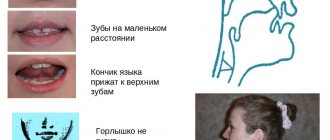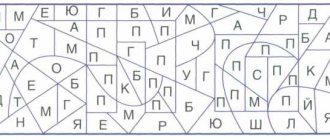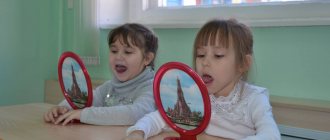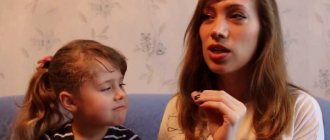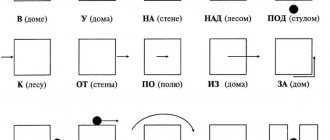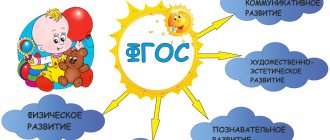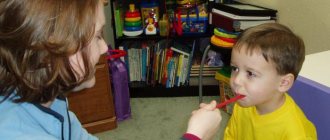Few preschool children manage to make friends with the sound “Zh” the first time. Being voiced, firm, consonant, it can appear in a child’s speech only after the sound “SH” has been successfully mastered. The reproduction system of “F” and “W” is the same, the difference is in how the vocal cords work. For example, with hissing, the throat area remains at rest, while with buzzing, vibration occurs.
When learning such sounds, children should clearly feel the tactile differences between “Zh” and “Sh”. Understanding how these sounds differ, preschoolers will learn to pronounce them easily.
How to give a child the sound “Zh”
Clear pronunciation of “F” requires proper functioning of the lips, tongue, vocal cords, and palate:
- The lips are rounded, the mouth should be opened slightly.
- The tongue must be kept at the edge of the upper palate. The middle of the tongue moves down, while its sides are raised and pressed against the teeth.
- The back wall of the tongue should be slightly raised and pulled back.
If all stated rules for pronunciation of sound are observed, an air stream must pass between the tongue and the palate.
Why doesn't a child pronounce the letter Z?
The sound “Zh” is a hissing noisy consonant, i.e. the noise that occurs as a result of an air stream overcoming an obstacle plays a role in its formation. Also, “Zh” is voiced, and its articulation requires the work of the vocal cords.
A speech therapist will help eliminate speech breathing defects.
Thus, problems in pronouncing the sound “F” in a child arise if there are defects in the articulatory apparatus or speech breathing. Another reason is hypertonicity of the muscles of the speech apparatus: the child cannot relax the tongue and stretch its edges over the upper lateral teeth.
The task of a speech pathologist is to teach a child to relieve tension in the jaw and tongue.
Norm of articulation of the sound “Zh”:
- lips are rounded, pushed forward;
- teeth are open by 1.5-2 mm;
- the wide tip of the tongue is raised to the edge of the hard palate or alveoli;
- between the tongue and the palate a gap is formed in the middle through which a stream of air passes;
- the tongue is pressed to the lateral teeth, its middle part is lowered;
- the back of the tongue is pulled back.
Gymnastics for correct pronunciation
In order for the child to master the sound “F” as quickly as possible, it is worth using special exercises. They are needed to train those parts of the face that are responsible for the clarity of pronunciation of this complex sound.
"Sweet dream on the tongue"
The child should be asked to relax the tongue and place it on the lower lip. During this exercise, the baby can imagine that the tongue is tired and has gone to bed. You should hold it this way for about 40-50 seconds.
"Tongue like a brush"
During this exercise, the mouth is slightly open, the tongue slides back and forth across the palate. Such manipulations resemble the work of a brush on paper. A child can use his imagination and think about what the tongue can draw.
"Sweet jam"
In this exercise you need to reach your upper lip with your tongue and lick it. The baby can imagine that he ate delicious jam, and now he is licking the remnants from his lips.
"Box"
The child is asked to open his mouth wide and try to fold his tongue into the shape of a small box. In this case, the tongue should be pushed forward a little. This exercise is considered one of the most difficult for preschoolers, but thanks to it, sound is mastered faster.
How to teach a child the letter "Zh"
In order to teach a child to say the letter “F”, parents do not have to seek help from a speech therapist. Training can be done at home with the help of special gymnastics, learning words that contain it, looking at pictures. It has been proven that learning in a playful way gives better results than drilling a child.
The effectiveness of training depends on preparation for it. Therefore, the first thing that needs to be done is to prepare the child for the upcoming lesson, provided that he is in a good mood. You should not conduct classes at a time when the child is worried about something or does not show interest, because such training will not bring results.
First, you need to prepare your baby’s articulatory apparatus for the lesson:
- Place the protruding tongue first on the lower lip, then on the lower teeth. Lightly tap it with your upper teeth, then let your tongue rest.
- With your tongue sticking out, draw a line from the upper edge of the upper lip to the inner edge, as if licking it.
- Bring your lips together into a tube and, using maximum effort, try to blow away a piece of paper located opposite you, or another light object.
Having prepared the articulatory apparatus, the baby needs to be given a little rest, and then move on to the next stage. During learning, attention should be paid only to the letter being studied in order to concentrate the baby’s attention on it.
Correct breathing training
When producing the sound “Zh”, not only the articulation process is important, but also breathing. We have already talked about the air stream that passes between the tongue and the palate during the pronunciation of a sound. Special breathing exercises will help you create it.
"Blow away the fluff"
During this exercise, the child's tongue should be pressed against the upper lip. A small piece of light material (paper, cotton wool, napkins) is placed on the child’s nose. Holding the tongue in its original position, the child should try to blow off the “fluff” from his nose. It is recommended to repeat the manipulations 2-3 times.
"Boiling Water"
Place a straw for juice in a glass of water and ask the baby to make the water bubble using his breath. Despite the simplicity of execution, this exercise requires a lot of strength, but it perfectly trains children's breathing.
Breathing exercises
The correct production of the sound Z must certainly include not only articulation, but also breathing exercises. Special exercises allow you to develop a directed air stream.
- Fluff: The tongue is wide, raised to the upper lip, its edges are also raised and reach the corners of the mouth. A small piece of cotton wool or napkin is placed on the child's nose. You need to try to blow the snowflake off your nose. The exercise is repeated several times.
- Storm in a glass: Water is poured into a glass and a straw is placed. The child is invited to create a “storm” in it by exhaling air through a straw.
The production of the sound Ж is, first of all, carried out by imitation. The adult draws the child’s attention to the vibration of his own throat, after which he invites him to also pronounce the sound Ш “with a voice.” If the sound turns out clear, then you can move on to automating it in syllables and words.
If difficulties arise at this stage, then you need to analyze articulation errors and eliminate them.
It is very useful to work on differentiating the sounds Ш and Ж, Ж and З before starting to automate a new sound. This is beneficial for all children, but is especially important for those who have phonemic awareness difficulties.
For this purpose, you can use simple speech therapy games:
- Clap when you hear the sound!
The adult clearly pronounces the syllables zha-zu-zy-zhe-zy-sy-zhi-shi-zhi, etc., the child must “catch” (clap his hands or stamp his foot) the syllable with “Zh”
- Choose pictures with words that begin with the desired sound.
- Who can come up with more words starting with this sound?
It is also important to connect the sound Zh and the letter Zh; for this you can use the following games:
- assemble a letter from pieces (like a cut picture)
- lay out a new letter from buttons, pebbles, shells, etc.
- trace the letter on semolina, in the sand, on the board
- color in the shapes where you see the letter z
Pictures with letters
For this game you should select pictures that show the required letters. The children are asked to remember words that begin with this letter. The one who remembers the most necessary words wins.
Puzzles
This game will help preschoolers associate the letter “F” with its sound. A large picture with a letter is cut into several parts. The guys must assemble the resulting puzzle. You can also invite them to lay out “F” from available materials: sticks, buttons, etc.
Draw a letter on scattered sand or grain
The kids will probably be interested in drawing on sand or semolina. By drawing the letter z, you can not only remember what it looks like, but also train fine motor skills. Those who like to color more can be given the task of finding the desired letter in the picture and coloring it in.
Basic methods of producing the sound Zh
Stages of phoneme production:
- Preparatory. The articulatory apparatus is warmed up, the child gets ready for classes, and work is done with speech breathing and phonemic hearing.
- Sound production. Speech therapy exercises are carried out to differentiate the problematic sound and pronounce it correctly.
- Automation. Clear sound pronunciation without additional assistance.
- Consolidation in everyday speech. Adult control, positive reinforcement.
Methods for correcting sound pronunciation:
- mechanical - using speech therapy instruments (spatula, spatula, probe);
- by imitation - the most natural way for preschoolers, because their articulation develops through the perception of the speech of others;
- by production from other correctly formed sounds.
Staging “F” begins with relaxing the tongue and jaw, because a wide tongue is the basis for the pronunciation of sibilants. To do this, use the following exercise: place your tongue on the lower teeth, the upper teeth lightly knock on it for 20 seconds. Then the tongue, without moving, lies on the lower jaw.
After this, the articulation of sound is explained. The speech therapist, together with the child, depicts a cup of water with his hands, then asks him to repeat the pose with his tongue hidden behind his teeth. In this position you need to say “ZZZZZZ”. The sound is automatically converted to “F”. When “F” is fixed, it is introduced into syllables with vowels, then into words and sentences.
You can also put “F” from a correctly formed “W”. The position of the lips, teeth and tongue when pronouncing these sounds is the same. The child says the sound “SH”, and the teacher asks to add a voice and feel the vibration on the vocal cords. To reinforce “F,” they use imitations of the buzzing of a beetle or bee.
After fixing the pure “F”, they begin the automation stage and introduction to the active dictionary.
Staging the sound “zh” step by step
The sound production lesson takes place in 3 stages. It is carried out in the form of a game in a group of 4 – 5 children.
At the first stage, children are shown how the tongue should be positioned when pronouncing a sound.
The second stage of sound production
The speech therapist finds out how the child pronounces the sound “zh” and what errors in articulation he makes. At the same stage, articulation and breathing exercises are carried out and they begin to practice the sound “zh” (provided that the students pronounce “sh”). Most children begin to say it by imitation - this is the simplest method of making the sound “zh”.
Exercise "Bug". The children are shown a picture of a beetle and asked to remember how the bugs flew and buzzed in the summer. Then they ask you to repeat this sound.
Exercise "Ball". Children are asked to imitate the hissing sound when the balloon bursts. And then - say the same thing, only with a voice.
Exercise "Voice". Students are asked to repeat the hissing sound (the “sh” sound) and at this time place their hands on their necks. They ask: “What does the little voice do? Is he sleeping or singing? The children will answer that he is sleeping. Then they are asked to say “sh” with the voice - they will note that now the “voice is singing” - a vibration has appeared in the neck.
By the same analogy as in the “Bug” exercise, the games “Fly in the Web” and “Bees Collect Flowers” are played. During the process, it is important to control correct articulation.
These speech therapy exercises can be done with the baby and at home to consolidate the skill.
The third stage of the lesson is sound production
Children learn to correctly pronounce the sound “zh” in words and phrases. The main condition is that they must clearly and unmistakably speak the sound in isolation. To do this, conduct an exercise with pictures.
First, the teacher selects pairs of pictures - subject and plot. On the object ones, an object is drawn, the name of which contains the sound “zh”. Words in which it comes at the end or before voiceless consonants are not suitable. The plot pictures depict situations in which the object shown in the first pictures is missing. For example, a girl with paper (scissors), a boy on a slide (skis), a house in flames (fireman).
Exercise No. 1. The teacher shows several plot illustrations and asks the students who is missing what. They call.
Exercise No. 2. Children are shown object pictures and asked to name what is drawn on them. They call.
Exercise No. 3. The teacher asks who needs the depicted object. The children answer, for example: “The girl needs scissors to cut paper.”
This is how all plot pictures go. When performing speech therapy exercises on the sound “zh”, children should highlight it in their voice - speak a little longer than other sounds.
The final stage of correction is automation
The production of the sound “zh” is gradually completed by automation. The goal is to teach children to pronounce sounds correctly in isolation, in syllables, words and phrases.
Carry out in several stages:
- Isolated sound pronunciation. Imitation of the buzzing of a bumblebee, bee, beetle, spinning top;
- Pronunciation in syllables. Here is a list of syllables for speech therapy exercises for the sound “zh”: “zha”, “zho”, “zhu”, “zhi”, “zhe”;
- Pronunciation in combinations of syllables. List of syllables in the speech therapy exercise letter “zh”: “zha-zha-zha”, “jo-jo-jo”, “zhu-zhu-zhu”, “zhi-zhi-zhi”, “zhe-zhe-zhe”, and then: “zha-zho-zhu”, “zhi-zhe-zha”, “zhu-zho-zhe”, “zhe-zha-zhe”, add one more syllable: “zhi-zha-zho-zhe-zhe” ", "zhu-zhu-zhu-zhi-zhe", "zhu-zha-zho-zhi-zhe";
- Pronunciation in words. The speech therapist selects words based on the syllables: “zha”, “zho”, “zhe”, “zhi”, “zhu”, “zhe”, as well as “zhd”, “zhg”. First, these syllables occur at the beginning of the word, then at the end, then in the middle;
- Pronunciation in words with consonant clusters. For example, trunk, friendship, clothes, diligent, scissors, southern;
- Pronunciation of words with two “w” sounds. Here is a list of words: thirst, buzz, yellow-skinned.
In all exercises, when pronouncing syllables and words in a voice, the sound “w” is emphasized.
They also play the game “Name it kindly” with children. They give a list of words, and students form a noun with a diminutive meaning. These words are: snow, hedgehog, boot, knife, haystack, beach, rain, iron.
They reinforce the skill by reading texts and tongue twisters in which the sound “w” is often found.
